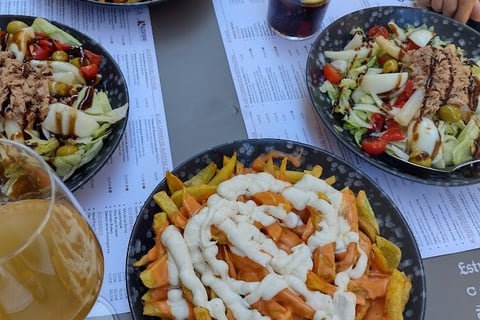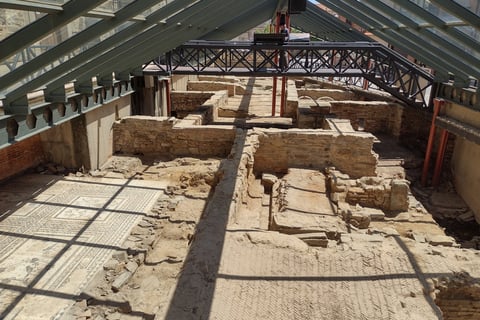Spotlight on cities and towns on the Camino
All Caminos pass through unique cities and towns, each with its own charm and character. Let's take a look at some of them.
Mario Picoas
4/25/20253 min read


Astorga: A Pilgrim’s Jewel on the Camino Francés
There is a unique excitement of seeing Astorga for the first time. Walking for so long across the dry countryside of Spain can get monotonous, but seeing it appear on the horizon after a hard day’s walk is a welcome sight. That promise of a little rest and discovery after seeing the hilltop city of Astorga rise over the horizon and the towers of the cathedral beginning to grow, alongside Gaudi’s palace, means so much to you as the long walk and exhaustion fade away. For every pilgrim on the Camino de Santiago, Astorga is not just a place to stop and rest, but it is a destination, a crossroads that is steeped in history and culture, along with a whiff of chocolate.
Arriving in Astorga: The Pilgrim’s Approach
As you near Astorga on the Camino Francés, the land starts to change. The city is perched atop a hill and can be seen for miles around, a guiding light for travelers looking for comfort. The last stretch before entering Astorga may seem long as you walk through the outskirts of the city (used to be a city before a suburb was formed), sometimes less than picturesque, but full of life and energy with fellow pilgrims continuing their way to see the city walls and cathedral spires in the distance.
Next, you will cross the railway tracks on a modern overpass, which is a modern reminder that the Camino, while centuries old, is a living, ever-changing journey. The ascent is gentle to the city and upon reaching the top, the view across the Maragatería region is breathtaking, with the city roofs of Astorga in the distance.
A City at the Crossroads of History
Astorga’s story stretches back over two millennia. Founded as Asturica Augusta by the Romans, it quickly became a vital hub for trade, especially in gold from the surrounding mines. Its strategic location made it a crossroads for Roman roads, including the famed Vía de la Plata, and later, for the Camino de Santiago.
In the Middle Ages, Astorga flourished as a major pilgrimage center. It boasted as many as 25 pilgrim refuges, offering shelter and care to travelers from across Europe. The city’s formidable Roman walls—some of which still stand—protected not just its citizens but also the countless pilgrims who have passed through over the centuries.
First Impressions: What Awaits the Pilgrim
When you enter the city, it won’t take long to discover the delightful compactness of Astorga's historic quarter--it's easy to walk around and there's always a lot of activity. The majority of the sights and remarkable pieces of architecture are located in close proximity to each other, a great opportunity for tired-feet pilgrims on a time crunch. The Plaza Mayor, home of the city’s historic, 18th-century town hall, and a number of cafés and bars, is the gathering point for Astorga social life. If you happen to arrive late in the afternoon, the square offers a frenetic atmosphere with Spanish and foreign tourists alike. Make sure to catch the mechanical Maragato figures striking the clock on the town hall tower.
Must-See Sights in Astorga
Even if you’re only staying for a few hours, there are several sights no pilgrim should miss:
Astorga Cathedral: Construction began in the 15th century and spanned three centuries, resulting in a stunning mix of Gothic, Renaissance, and Baroque styles. The cathedral’s twin towers make for a striking silhouette, especially in the golden light of sunset. Inside, you’ll find impressive altarpieces and religious art, as well as an image of St. James dressed as a pilgrim.
Episcopal Palace: Designed by Antoni Gaudí, this neo-Gothic marvel looks like something out of a fairytale. It’s one of only three Gaudí buildings outside Catalonia and houses the Museo de los Caminos, dedicated to the history of the Camino de Santiago. The palace’s whimsical turrets and stained glass are a photographer’s dream.
Roman Walls and Archaeological Remains: Wander along the remnants of Astorga's Roman walls, some of which date back to the first-century. You can visit portions that are close to the town centre, and the Roman Museum provides an excellent overview of the city's ancient past, including mosaics from the first century, and the ruins of thermal baths.
Chocolate Museum: Astorga is considered the birthplace of chocolate in Europe! The museum is a fun, quirky stop where you can learn about the city’s chocolate-making tradition, sample some treats, and maybe pick up a sweet souvenir for the road.
Town Hall: Located on the Plaza Mayor, the town hall’s unique clock and Maragato figures provide a bit of local color. Try to catch the clock’s show on the quarter, half, or full hour.
Church of Santa Marta: A small but significant church dedicated to the city’s patron saint, located in the shadow of the cathedral.
Pilgrim Hospitality: Food and Rest
Astorga has a long tradition of welcoming pilgrims. Today, you’ll find a range of albergues (pilgrim hostels), hotels, and guesthouses to suit every budget. After a day’s walk, treat yourself to a “menú del peregrino” at one of the local restaurants—Astorga is famous for cocido maragato, a hearty regional stew, and of course, its chocolate.
¡Buen Camino!




